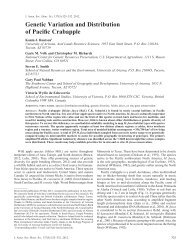CONSERVATION
Conservation You Can Taste - The Southwest Center - University of ...
Conservation You Can Taste - The Southwest Center - University of ...
- No tags were found...
Create successful ePaper yourself
Turn your PDF publications into a flip-book with our unique Google optimized e-Paper software.
assuring economic needs of growers, millers and<br />
chefs are met are among the current challenges of<br />
Anson Mills and the Foundation. As a crop suited to<br />
cultivation on floodplains near the coast, it remains<br />
vulnerable to massive flooding and susceptible to<br />
the the catastrophic events that are becoming more<br />
frequent with accelerated climate change. As such,<br />
“the storage of three years worth of uncontaminated<br />
seed is critical to preventing a complete collapse of<br />
the commercial crop” Roberts cautions those who<br />
may think there will inevitably be instant access<br />
to foundation seed. Additionally, Roberts says that<br />
“adoption of sustainable practices such as SRI – a<br />
rigorous System of Rice Intensification – with mixed<br />
cropping, polycultures, and whole farm husbandry<br />
will be integral to the success and increased<br />
production of the rice”.<br />
Today, just a handful of farms outside the Anson<br />
Mills co-op produce the rice, and they are scattered<br />
between the Carolinas and Texas. One notable new<br />
development is the activity of Campbell Coxe of<br />
Carolina Plantation Rice, who is currently working<br />
to ramp up his production to 50 acres of rice in<br />
South Carolina. Meanwhile, at Anson Mills, Roberts<br />
continues his focus on pre-industrialization practices<br />
that produce a grain that is a bit more expensive<br />
(than machine harvested rice), contains exceptional<br />
nutritional value, and stunning aromas and flavors;<br />
the only drawback is that Anson Mills’ handharvested<br />
rice is very perishable. Because of this,<br />
Roberts is very particular about how his products<br />
are shipped and how they are handled once they<br />
are received by Anson Mills’ 4000 chef clients<br />
worldwide. Anson Mills also offers tours regularly<br />
and Roberts encourages the chefs to hand harvest<br />
the Carolina gold rice - to cut, thresh, winnow and<br />
pound all by hand - “so that they can appreciate<br />
what we do...when chefs come here and work with<br />
us, they immediately understand why the prices are<br />
what they are”.<br />
Glenn Roberts well understands that his<br />
vertically-integrated approach to on-farm research,<br />
historic research, seed increase, new farmer<br />
mentoring, seed cleaning, packaging and delivery<br />
goes far beyond what many other heritage food<br />
promoters are currently capable of undertaking:<br />
“What I do is truly unique. By the time<br />
I have a mature product available to sell,<br />
we’ve invested over $3 per pound into it, not<br />
including the production of the seed, which<br />
I’ve provided the farm free of charge...But (I do<br />
it this way because) I’m not just making rice<br />
available to the public, I’m building (long-term)<br />
seed biosecurity.”<br />
Repatriation of Carolina gold to the Low<br />
Country has taken place slowly, yet it is gaining<br />
momentum. And now, what is re-emerging is that<br />
this Antebellum heirloom grain is found once again<br />
in its proper place in many dishes originating from<br />
the Carolina Rice Kitchen table. Thankfully, Carolina<br />
gold rice is also turning up in restaurant dishes all<br />
across the country, not just on its cradle of origin.<br />
35



